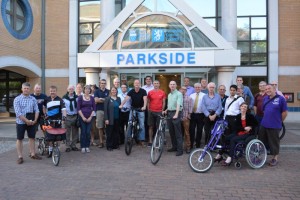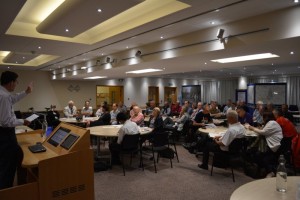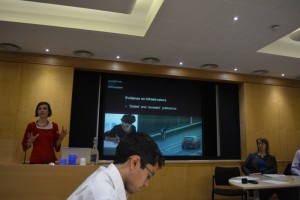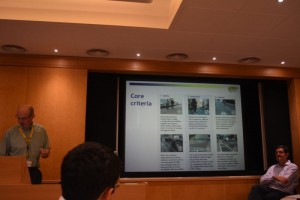Over 40 people crowded into County Hall North on the 9th July to hear some of the country’s top speakers on cycling talk at the Horsham Cycling Summit.
The event was attended by councillors and officers from HDC and WSCC, representatives from local groups such as the Horsham Society, Horsham Blueprint, Horsham Town Community Partnership, local businesses – as well as many local people who simply want somewhere safe for them and their family to get about by bike.
There were also representatives from national organisations such as Sustrans and CTC.
Before the event, delegates had the opportunity to see and try out a range of transport bikes including an electric bike and a handcycle. Many thanks to Roger Butler from The Cycle Room, Mathew Wing from Surrey Wheels for All and Sarah Sharp for bringing along bikes.
During the evening’s presentations, we heard of the large body of evidence from the UK and around the world which shows that creating the right conditions for cycling has a real economic and social benefit for the whole community.
Research by our speaker Dr Rachel Aldred and others shows that to get a real increase in cycling, including among women, children and the elderly, we need to improve the conditions on our roads.
Mark Strong, an experienced transport consultant, showed examples from around the country and overseas of the kind of best practice infrastructure that really makes cycling safe and attractive for everyone.
You can see the presentations here:
- Ruth Fletcher – Cycling benefits the whole community
- Dr Rachel Aldred – Realising the benefits of cycling
- Mark Strong – Cycling infrastructure we can build now
More cycling benefits the whole community
Cycling is very space efficient, which is important in the centre of town – especially with the major new developments around Horsham which are too far from the town to walk but are within a comfortable cycling distance.
More cycling is good for trade too: cyclists tend to shop more often and, overall, spend more – especially at the independent shops and cafes which help make Horsham such an attractive destination.
Modern high-wage employers of the sort we are actively seeking in Horsham District choose to locate to places with good cycle networks. One hi-tech company says that its recruit profile is:
“someone who is young and fit, will work long hours, and expect to be able to cycle safely to work as a way of getting good daily exercise.”
Cycling gives reliable commute times: workers arrive less stressed and take fewer sick days.
The biggest financial benefit of cycling is the improvement to health – both for individuals and by improving air quality and noise levels for others.
Dr Rachel Aldred, Senior Lecturer in Transport at Westminster University, spoke about how research conducted by herself and others shows that most people, especially women, children and older people, will only choose to cycle if they can ride where they feel safe – away from fast and heavy traffic.
To get a step change in the level of cycling and see these benefits in our community, we need a network of cycle routes which are both safe and direct. Busy roads need cycle paths which are physically separate from the traffic and ‘filtered permeability’ which cuts out rat-running and reduces speeds and traffic volumes is required for residential roads.
The on-road cycle lanes we have built in the past are not effective. It is not enough to encourage people to cycle and not provide anywhere safe for them to ride.
The three key types of preferred infrasructure are:
- Completely away from motor traffic (greenways)
- Physically protected infrastructure on busier roads
- Very lightly trafficked residential streets
Mark Strong, from Transport Initiatives, a transport consultancy based in Brighton talked about his experience of building real infrastructure that is helping encourage people to cycle. This is the sort of infrastructure that we can build today. You can see it today in places like Brighton, Bristol or Cambridge as well as elsewhere in the UK.
Key points from Mark’s presentation:
Horsham should be an ideal place for cycling because it is flat and compact.
Design standards for cycling infrastructure continue to improve rapidly and the London Cycling Design Standards are currently the-de facto national design standard.
Cycling provision has to work for all levels of expertise, for both fast and slow cyclists: there should be no dual network.
Base it on a Bikeability audit. To get mass cycling your network must be rideable by level 2, which can be achieved by year 5 (10 year old).
For big schemes you need to properly assess the need and benefits but there are many valuable small scale interventions which are cheap and effective.
There is no reason why you shouldn’t have two-way cycling on almost every residential street, even the narrowest. Recent safety tests in London have shown that this is safe and effective.
The presentations were followed by a lively Q&A session
Rupert Emerson (Chichester Cycle Forum) raised the issue of pedestrian refuges down the centre-line of roads take up valuable space for cycle lanes (e.g. on the proposed “Chemroute” between Chichester and Emsworth).
There was a strong feeling from several delegates that “nothing is happening” and that much of the infrastructure in Horsham is useless, or worse than having nothing at all. The LSTF east-west route specifically was regarded as a waste of money, consisting of little more than signage.
Mark Strong said unitary councils [which combine the planning and transport functions] have been much more effective in delivering cycling schemes. We need better communication between HDC as the planning authority and West Sussex as the highway authority.
Liz Kitchen (Con, Rusper and Colgate) said cycling must be designed-in when we build new roads.
Jim Rae (Ind, Roffey) repeated the call for HDC to make the cycling forum a statutory consultee in the planning process so that cycling can be considered and planned for from the earliest pre-application stages of the planning process.
In response Claire Vickers (Con, Southwater) said that it is not possible to become a statutory consultee although in the case of the north of Horsham development, the cycle forum would be invited to the reference group meeting.
Regardless of whether the forum was technically a statutory consultee, there was support from the floor for HDC involving the forum in early and regular consultation on planning matters.
Rachel Aldred said the London Cycling Campaign gets consulted pre-application and this is very effective.
Mark Strong said that Brighton have set up pre-application stakeholder groups (whose members must sign a non-disclosure agreement) so that the interests of cycling could be incorporated in early discussions. This works very well.
Brad Watson (Con, Southwater and Nuthurst) said that the cycling lobby needs to have a strong voice.
Peter Smith (CTC Crawley) said Crawley Borough Council actively support the Crawley Cycle Forum and consult with the forum. As a consequence they have managed to get £400,000 of s106 money for cycling. Peter stressed the importance of engaging with councillors and officials.
Phil Burroughs (Sustrans Bike It Officer) spoke of the enthusiasm he sees when training young children to cycle to school, but that these children will simply not continue to ride (and their parents will be reluctant for them to continue to do so) without safe infrastructure. There is a massive appetite for cycling in Horsham schools and spending on infrastructure will be money well spent.
Doug Ralph (and others) said the Southwater to Horsham route is treacherous and queried when a safe route is going to be built. Delegates from Warnham expressed similar sentiments about a safe route to Warnham.
Mark Strong suggested HDC have an SPD (Special Planning Document) which goes into the detail of how your strategy can be effective.
There was clearly frustration from delegates at the lack of any mechanism for bringing cycle schemes to fruition. A common theme was also the repeated lack of consideration for cycling in major new developments (of which John Lewis is just the most recent example) where providing for cyclists has not been considered as part of the planning process in the same way that it has for pedestrians and motorists. Cycling to the new store involves a ride along a busy dual carriageway and then a right turn at a roundabout across two lanes of motor traffic. Most customers will simply choose not to cycle.
We are really sorry we had to postpone the roundtable discussions on local issues. We hope to find a way to allow you to get involved in this at a later date.
Open Forum Monday 20th July
The large turnout for the Summit and the passionate involvement of delegates demonstrates the strength of support for change.
The next stage in this process is an Open Forum at 7:30pm on Monday, 20th July in County Hall North where we will be providing an update on what’s been happening since the Summit and discussing how we want the Forum to work in the future.
We’ll be looking at:
- Wider engagement, especially with other local groups
- Meaningful contacts with HDC and WSCC
- How to support the Task & Finish Group
- Building a strong steering group
Please do come along. We can only be effective with your support!
Some quotes from delegates
“I gave away my cycle as I felt it was just too dangerous with fast road and impossible roundabouts.”
“The cycling infrastructure in Horsham is simply pitiful. As a regular cyclist I cannot think of one single decent cycle route.”
“I cycle into Horsham from Southwater and the Hop Oast roundabout is not cycle-friendly and nor is the Worthing Road into Horsham.”
“I avoid the cycle lane on Guildford Road due to the constant stop/start at the road junctions.”
“Kerves Lane – cars driving too fast and cutting corners.”
“Crossing the A264 from Warnham (hell!!!)”
“Many streets in Horsham could be made safer for cycling cheaply by filtered permeability.”
“Horsham is a small town where 50% of journeys could easily be made by bike.”
“Horsham should aim high and be the town that areas look up to for how to turn your town into a cycling hub.”
Picture credits: Mark Treasure/@AsEasyAsRiding





Speak Your Mind